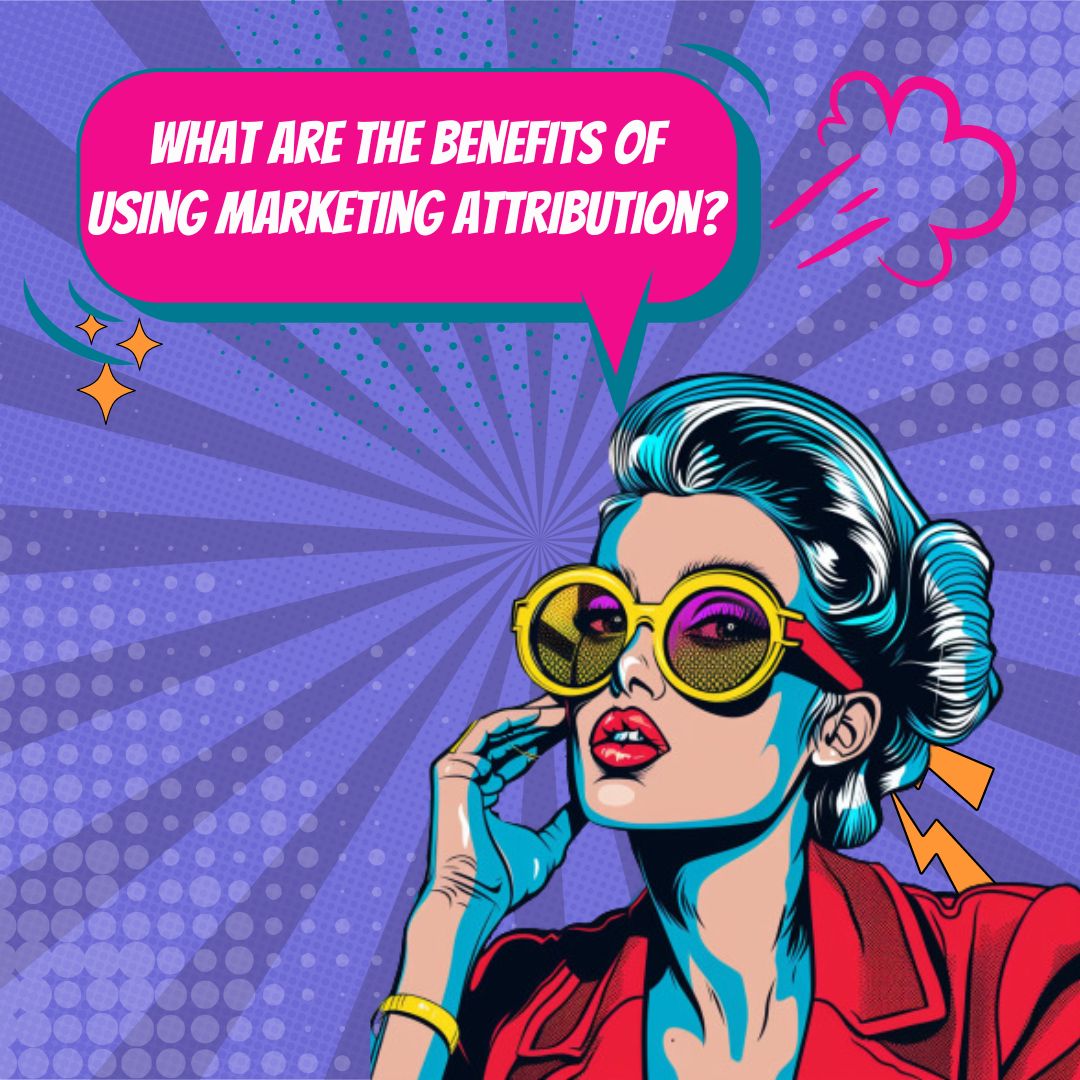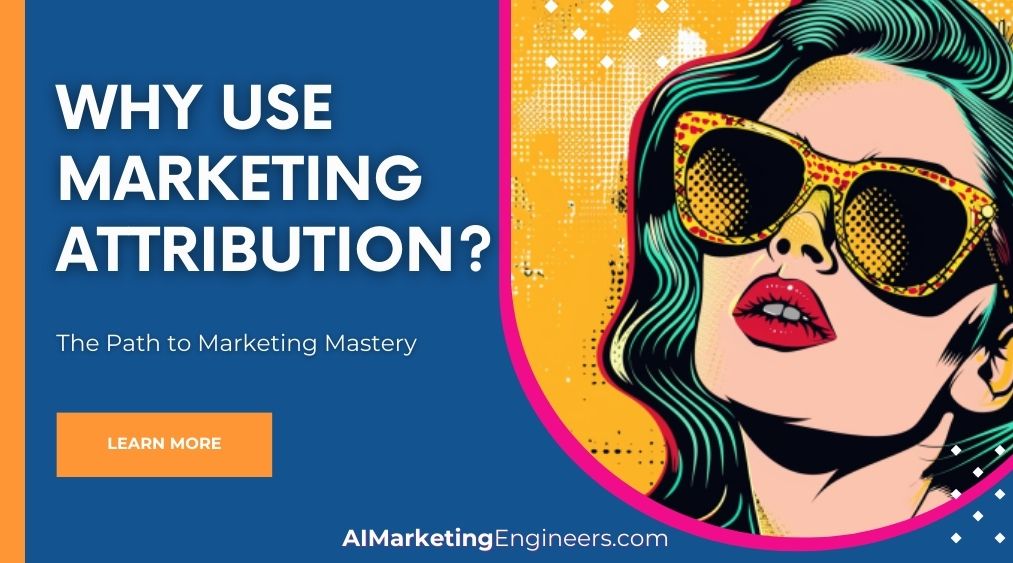Key Takeaways
✅ Improved Decision-Making: With marketing attribution, you'll discover which parts of your advertising are true heroes – the campaigns, channels, and moments that win your customers over. Shed light on these paths and you're on your way to smarter spending and soaring revenue – that's data-driven decision-making at its best.
✅ Better Customer Understanding: Peel back the layers of customer behavior with marketing attribution and get to the heart of what your audience loves. Armed with these insights, you can craft experiences that feel tailor-made – because they are – making every marketing moment resonate with personalized precision.
✅ Enhanced Cross-Channel Coordination: Attribution isn't just about tracking; it's a team sport. By pinpointing the winning moves across different channels, everyone can rally together to deliver a strategic play that scores conversions. This isn't just teamwork; it's your roadmap to marketing synergy and success.

Introduction
Ever wonder why some ads stick in your mind, or why you choose to click one brand's email over another? It's no coincidence – it's marketing magic at work. But behind that magic is a method, and it's called marketing attribution. Think of it as the crystal ball of the marketing world, offering a glimpse into the twists and turns of your customer's journey.
Marketing attribution isn't just a buzzword; it's the silent powerhouse steering the ship of savvy marketers towards richer relationships and heftier profits. By mapping out which ads, emails, and posts turn browsers into buyers, you can sprinkle that fairy dust where it counts. Ready to peek behind the curtain? Let's dive into a world where every move is measured, and every strategy is strengthened. Keep reading, because we're about to unveil some game-changing strategies that will help you sharpen your aim and hit the bullseye with your marketing dollars.
Top Statistics
| Statistic | Insight |
|---|---|
| 74% of B2C marketers see attribution modeling as "very important" or "critical" (Forrester Research, 2020). | That's most marketers shouting that attribution isn't just nice to have – it’s a must. Could it be what's separating the best from the rest? |
| 68% of marketers are boosting their investment in attribution tools (AdRoll, 2021). | More bucks are pouring into attribution tech. That's a pretty hefty hint that it's paying off, don't you think? |
| The marketing attribution software market is ballooning to an expected $2,519 million by 2028 (Grand View Research, 2021). | The market's swelling fast! If that's not a sign to get on board, what is? |
| 80% of organizations will soon ditch old-school metrics for multichannel attribution (Gartner, 2024 prediction). | Old school's out, and the new wave is multichannel attribution. It's what the cool kids are doing – are you? |
| Advanced analytics could boost lead gen rates by a whopping 120% (McKinsey & Company, 2020). | When leads are the lifeblood of sales, a 120% spike is kind of like striking gold, don't you agree? |
 Understanding Marketing Attribution
Understanding Marketing Attribution
Ever wondered how businesses figure out which marketing efforts really lead to a sale? Picture yourself following a trail of digital footprints to uncover the mystery of a successful marketing strategy. That's marketing attribution in a nutshell. It helps companies understand the path you took, from an online ad to a newsletter signup, right through to buying that pair of shoes. By identifying which steps in their marketing plan are bringing customers through the door, businesses can make smarter decisions about where to spend their time and money.
Decoding the Customer Journey
Remember the last time you clicked on a Facebook ad and ended up buying something? Now, could you say for sure it was just that ad that sealed the deal? Chances are, you've interacted with the brand multiple times across different platforms. For companies, it’s like putting together a multi-channel puzzle—each piece, from social media to email campaigns, plays a role. But which channel deserves the most credit? Marketers are always trying to map out this journey to understand which parts of their strategy work best.
Reaping the Rewards of Smart Attribution
Here's where the game gets exciting. Imagine being able to point at your marketing efforts and say, "That one! That's what’s making us the big bucks!" That's the power of effective marketing attribution. It's about getting to the heart of what's effective, seeing where to put your resources for the greatest impact, and, most importantly, understanding your customer’s experience. By doing this, each campaign you roll out can perform better than the last, resonating with your audience in a way that truly counts.

Peeking Behind the Curtain: Marketing Attribution Models
Ever stood in front of a shelf full of shoes and wondered which pair would fit just right? Choosing an attribution model for your marketing efforts is a lot like that. There's the straightforward first-touch attribution, where the first ad or contact gets all the credit for the victory lap. It's like giving a medal to the guy who started the race. Then there's the last-touch attribution, tipping its hat to the last thing that caught the customer's eye before they hit 'buy'. Of course, we can't ignore multi-touch attribution models, like the linear model—a democratic approach that gives equal credit across the board. Or perhaps the time decay model, which plays favorites with the newer interactions. And then, there's the varsity player, data-driven attribution, which uses algorithms and machine learning to assign credit. It's like having a personal shopper who knows exactly which shoe fits your foot best. Each model has its strengths and weaknesses, and the choice depends on your unique marketing puzzle.
The Strategist's Dilemma: Selecting Your Attribution Model
Feeling like a strategist about to enter the battlefield? Picking the right attribution model is crucial and requires some insight into your campaign goals. If your strategy is about quick wins, perhaps the first-touch or last-touch model might suit you, but let's not forget the virtues of patience and long-term thinking. If you're in it for the long haul, a multi-touch model might be the way to go. But how do you settle on one? Assess your customer’s journey, consider the complexity of your marketing channels, and most importantly, understand what decision would provide the most beneficial insights. It's like dating; sometimes you have to meet a few different 'models' to find the one that complements you best. By aligning the model with your business objectives, you can measure the effectiveness of your marketing activities with greater accuracy and make data-driven decisions.

Sharpening the Saw: Best Practices in Marketing Attribution
Let's get down to the brass tacks. To make sure your marketing attribution is as sharp as a tack, you've got to start with quality data. If the data's messy, your results will be too. So, first things first: ensure your tracking is consistent and that you're taking a good, hard look across all channels – it's about maintaining a bird’s-eye view while keeping an eye on the details. It might seem like quite the juggling act, but once you get it right, you're golden. Up next, you'll want to fine-tune that attribution model of yours. Just like a trusty car, it needs a regular tune-up to handle the bends and curves of the modern marketing racetrack. And remember, it's a marathon, not a sprint. Periodically re-evaluate your strategy because what worked yesterday might not work tomorrow. Be prepared to adapt, stay informed, and dare to test new models. That's how you keep your marketing engine running at peak performance.
AI Marketing Engineers Recommendation
Recommendation 1: Invest in Multi-Touch Attribution (MTA) Models: You know how it feels when you try to put together a puzzle but you're missing a few pieces? It's frustrating, isn't it? Well, that's what it's like when businesses ignore the different touchpoints a customer interacts with before they make a purchase. Multi-Touch Attribution models help you see the whole picture. By analyzing customer interactions across various channels and touchpoints, these models provide a more nuanced view of what's really driving conversions. Through data-driven insights, companies can allocate their marketing budget more efficiently, ensuring that each dollar is spent where it's most effective. Why throw your money at the wall to see what sticks when you could be placing it directly in the hands of eager customers?
Recommendation 2: Leverage Predictive Analytics to Forecast Marketing Impact: Have you ever wished to have a crystal ball to tell you which marketing move to make next? Predictive analytics might be the next best thing. By tapping into Predictive Analytics, businesses can anticipate the future impact of their marketing strategies based on historical data. This isn't about fortune telling, but rather about smart, data-informed predictions. Current trends show that industry leaders are more frequently incorporating this forward-looking approach to stay ahead of the curve. When you predict the impact of your marketing campaigns, you can craft strategies that resonate with your audience and ultimately, give them what they want before they even know they want it.
Recommendation 3: Utilize Attribution Software for Real-time Data Analysis: Ever feel like you're too late to the party? In today's fast-paced digital world, real-time data is the invite everyone wants. By utilizing Attribution Software that offers real-time analysis, you can make swift, informed decisions that keep you ahead of the competition. This kind of software goes beyond just crunching numbers; it offers actionable insights that can directly influence strategy and execution. Imagine being able to adjust your campaigns on the fly, channeling resources into what's working and pulling back on what's not. Benefits? Increased ROI, less wasted ad spend, and the ability to be as nimble and responsive as your customers expect you to be.

Conclusion
So, what’s the big deal about marketing attribution? It’s like having a map in a treasure hunt; it guides you to where the gold—your customers and their purchases—is hidden. Without it, let's admit, you're just guessing which ads, emails, or social posts are really bringing in the business, and no one likes to play darts in the dark, right?
Attribution isn’t just about giving credit to a winning ad or a catchy email subject. It's about understanding which of your marketing efforts are working hard for you and, frankly, which ones are just taking up space. Do you want to know that your marketing budget is going towards strategies that actually drive conversions? Of course, you do.
Whether you’re a fan of the first kiss (first-touch attribution) or you’re all about who brought them to the dance (last-touch), or maybe you're fair and square and prefer to divvy up credit evenly (linear attribution), the key takeaway here is that there’s a perfect match for your business goals when it comes to choosing an attribution model. And remember, just because you pick one, it doesn’t mean you’re married to it. Feel free to date around—your business is dynamic and so should your approach to attribution be.
Now, before you jump into the deep end, make sure you’ve got your floaties on—that’s your data quality and consistency. And don't forget to keep your goggles clear by continuously analyzing and refining your approach. It’s a sea of information out there, and navigating it with the best marketing attribution practices is what will lead you to smoother sailing and, ultimately, success.
Have you thought about which part of your marketing could be the unsung hero bringing in the sales? Are you ready to give attribution a shot and unlock marketing success? Dive in, the water’s fine, and the potential for growth and success could be beyond the next wave!

FAQs
Question 1: What is marketing attribution?
Answer: Marketing attribution is like the detective work behind a successful sale or sign-up. It's about figuring out which parts of your marketing strategy convinced customers to take action, whether it was an ad they clicked, an email they opened, or a social media post that caught their eye.
Question 2: Why is marketing attribution important?
Answer: Think of it as a roadmap to what makes your customers tick. Attribution tells you which paths they took to find you and what got them to commit. It helps you spend your budget wisely, making sure every dollar you spend is actually working to bring in customers.
Question 3: Which types of marketing attribution models are commonly used?
Answer: Marketers use different maps to chart the customer journey. Some look at the first or last thing a customer interacted with, while others spread credit evenly or focus on key moments. There's a bunch of these maps—like first-touch, last-touch, and even those fancy data-driven ones that change with every new piece of information.
Question 4: How does multi-channel attribution differ from single-channel attribution?
Answer: Single-channel is like using a magnifying glass to look at one clue, while multi-channel is using a whole surveillance system across the city. Multi-channel gives you a big picture view, seeing how all the different marketing channels play together.
Question 5: What challenges do marketers face when implementing marketing attribution?
Answer: It gets tricky. You've got messy data, keeping track of customers moving across devices, trying to get all your tools to talk to each other, figuring out which map (attribution model) to use, and giving credit where it’s due when customers take a twisty-turny path to purchase.
Question 6: How does marketing attribution help improve ROI?
Answer: Once you know what's actually convincing people to buy, you can focus your energy and dollars there, cutting out the stuff that isn't working. That way, you're getting more bang for your buck, and that's what a better ROI is all about.
Question 7: Can marketing attribution be used for both digital and offline campaigns?
Answer: Yes, it can! It's a bit easier with digital stuff because it’s all tracked online, but with a few extra steps, like tracking phone call sources or using codes, you can connect the dots with offline marketing, too.
Question 8: What are the benefits of using data-driven attribution?
Answer: Using data-driven attribution is like having a smart assistant that's learning all the time, figuring out what’s working best by sifting through loads of data and spotting patterns you might miss if you were doing it the old-fashioned way.
Question 9: How can marketing attribution be used for budget allocation decisions?
Answer: It's all about finding your best bets. Attribution can show you which channels are like slot machines paying out big time, and which ones are just eating up your quarters. That way, you can double down on what works and tweak or ditch what doesn't.
Question 10: Are there any best practices for implementing marketing attribution successfully?
Answer: Sure, you've got to have a plan! Set clear goals, get your team on the same page, and make sure you're gathering clean, reliable data. Keep an eye on how things are going and be ready to make changes. It's a bit like gardening: plant your seeds, care for them, and adjust as you learn what makes them thrive.

Academic References
- Ameen, N. (2018). The Role of Attribution Models in Marketing. Journal of Digital & Social Media Marketing. https://doi.org/10.1362/247539718X15242484215191. Ameen dives into the significance of attribution models for dissecting consumer behavior, savvy budget allocation, and nailing accurate ROI. This one's essential for getting a grip on the actions consumers take and the digital marketing playbook.
- Gupta, S., Mela, C. F., & Lehmann, D. R. (2013). Attributing Sales Across Channels: An Empirical Analysis of Multi-Channel Marketing Effectiveness. Journal of Marketing Research. https://doi.org/10.1509/jmr.11.0476. Gupta and company offer us a peek behind the curtain of a big-time retailer and show us just how multi-channel marketing impact sales and draws in customers. Without this kind of knowledge, we'd be guessing in the dark about which of our many channels actually work.
- Singhal, S., Gopalakrishnan, V., & Crawford, D. (2018). Marketing Attribution Modeling for Online Advertising. McKinsey & Company. Retrieved from https://www.mckinsey.com. Here's where the techie side of attribution comes into play. Singhal, Gopalakrishnan, and Crawford break down how online ads work in the attribution game, lay out the hurdles, and then give us a battle plan for making our attributions count. Plus, they give the scoop on AI and machine learning to buff up accuracy.






